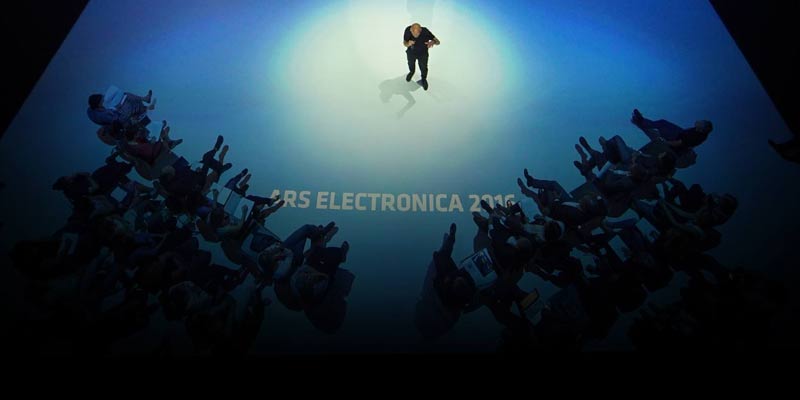Ars Electronica Center
Deep Space LIVE: The Reconstruction of the Old Linz Synagogue
Pressetext: Deep Space LIVE – The Reconstruction of the Old Linz Synagogue / PDF
Fotoalbum auf Flickr
Beitrag am Ars Electronica Blog
(Linz, March 14, 2017) Countless synagogues throughout Germany and Austria were plundered, wrecked and set ablaze on Kristallnacht, November 9-10, 1938. One of the Jewish houses of worship that went up in flames that night was the synagogue of the Linz Jewish Community. The beautiful classic structure at Bethlehemstraße 26 that had been dedicated on May 10, 1877 was torched by members of the Nazis’ SA and SS units. Now, thanks to a detailed digital reconstruction, visitors to the Ars Electronica Center’s Deep Space 8K can get a realistic impression of what the old synagogue actually looked like. And this Thursday, March 16, 2017, Cathrin Hermann, a scholar on the staff of the Linz Municipal Archive, will conduct a virtual tour of this house of worship and point out interesting details about its history.
The Old Linz Synagogue
On May 16, 1876, the Jewish Community of Linz laid the cornerstone for its first synagogue at Bethlehemstraße 26. It took about a year to construct the 25×17-meter structure with approximately 425 square meters on ground level. Its architectural design was oriented on the neo-Romanesque-style synagogue in Kassel, Germany with its characteristic arched windows and doors on both the front and sides. Although the structure had a markedly individual style, it was nevertheless a nice fit in the surrounding architectural ensemble. It sat on a pedestal which made it considerably higher than the adjacent structures; there were three flights of steps leading up to the main entrance. The synagogue’s interior, on the other hand, took leave of the Kasseler model—instead of the round arches and barrel vault ceilings that would have been in keeping with Romanesque historicism, the architect went with cast iron columns to support the galleries and ceilings. In the sanctuary itself, seating for the men was on the ground floor and the women in the upper galleries. The seats of honor reserved for the rabbi and the cantor were at the back wall opposite the main entrance. Six large double windows on both sides provided natural lighting by day; 16 ceiling lamps, a chandelier and numerous candelabras illuminated the space after sundown. With approximately 255 square meters of space, the sanctuary offered seating for 300 on the ground floor and 200 in the galleries. In 1906, the synagogue was expanded in order to add an additional 500 square meters of usable space to accommodate a vestry and an organ.
Virtual Reconstruction of Destroyed Synagogues
The Technical University of Vienna has been utilizing computer-aided processes to reconstruct destroyed synagogues since 1998. Initially, the focus was on Jewish houses of worship built during the turn-of-the-century construction boom. Even if the respective urban planning context exerted a modicum of pressure to exercise stylistic reserve, these synagogues were nevertheless a significant enrichment of the cityscape. And those whose aim was to destroy these synagogues and to eliminate the Jewish cultural heritage they represented left nothing to chance!
René Mathe Reconstructs the Linz Synagogue
Most of the detailed reconstruction models were produced in conjunction with degree projects. In René Mathe’s case, his work on the Linz Synagogue was to satisfy the requirements for a master’s degree at the College of Architecture and Design, where his faculty advisors were Bob Martens and Herbert Peter. The project got off to a rocky start: The Nazi regime’s endeavors to expunge all traces of Jewish life in Linz made it exceedingly difficult to find usable drawings of the old synagogue. René Mathe finally discovered what he needed in the archives of the City of Linz and the Linz Diocese as well as the Jewish Community of Vienna. The Jewish Museum of Vienna also provided him with access to text descriptions of the building and eyewitness accounts of the Kristallnacht pogrom. Another valuable source of information was the War Archive, including, most importantly, old aerial photographs giving an impression of the synagogue’s architectural context. Once René Mathe had assembled and evaluated all of these blueprints, photos and reports, he could begin generating an accurate reconstruction of Linz’s destroyed synagogue. He ultimately succeeded in creating detailed depictions that get across a truly realistic impression of this magnificent building.
Ars Electronica Futurelab Enables Visitors to Take a Virtual Tour of the Old Linz Synagogue
With the extensive work done by René Mathes as their point of departure, Ars Electronica Futurelab staffers produced a 3-D visualization that makes it possible to take a virtual walking tour of the old synagogue in Deep Space 8K. Virtual visitors enter the house of worship through the main entrance on Bethlehemstraße. They can soak up the ambience of the main sanctuary, and get an additional perspective touring the galleries one flight up.
About Cathrin Hermann
Cathrin Hermann studied history and art history at the Universities of Tübingen and Vienna. Since 2005, she has been involved in cultural education at several institutions. In April 2010, she began working as a volunteer on “Linz 1918 1938,” a project conducted by the Linz Municipal Archive, and has been a scholarly archivist on that institution’s staff since 2013.
http://www.flickr.com/photos/arselectronica/32590326804/
Virtuelle Rekonstruction / Fotocredit: Ars Electronica, Robert Bauernhansl / Printversion / Album
http://www.flickr.com/photos/arselectronica/30876568366/
Virtuelle Rekonstruktion / Fotocredit: René Mathe / Printversion / Album

